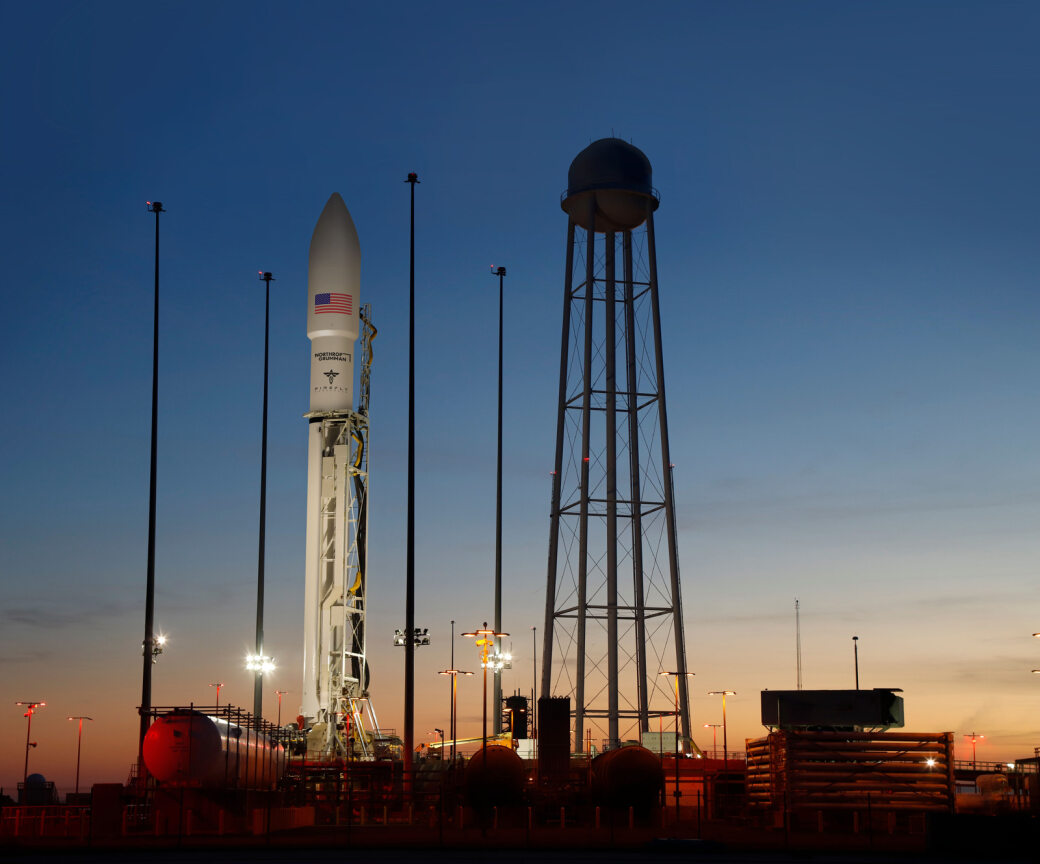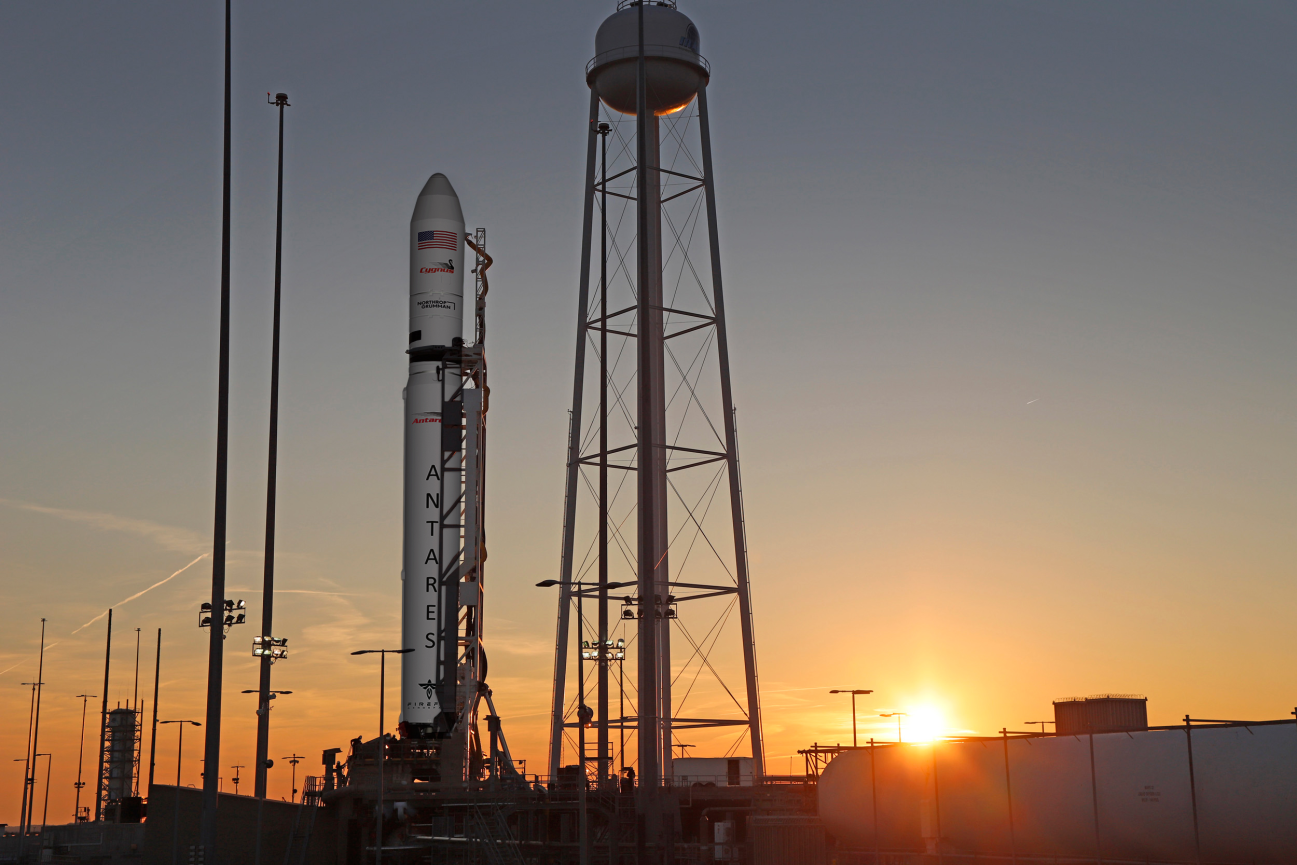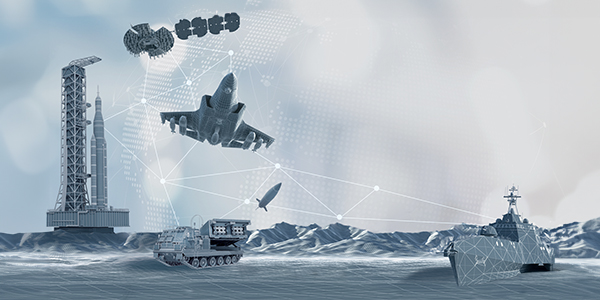
With all-new domestic first- and second-stage rockets manufactured by Firefly Aerospace, as well as an up-sized five-meter-class fairing, Northrop Grumman’s Medium Launch Vehicle will soon be flying cargo resupply missions to the International Space Station and other commercial missions. Rendering courtesy of Northrop Grumman.
In this Q&A with Northrop Grumman’s Kurt Eberly, director of Space Launch, we discuss: the latest on the Antares, Pegasus, and Minotaur rockets; as well as a new Medium Launch Vehicle being developed.
Breaking Defense: What’s the latest on Northrop Grumman’s rocket programs: Antares, Pegasus, and Minotaur. What are the key defense/government missions for these launchers?

Kurt Eberly is director of Space Launch for Northrop Grumman.
Eberly: Northrop Grumman has a long history with commercial space starting with the air-launched Pegasus rocket in the early 1990s. It was the first privately developed launch vehicle and has flown 45 times.
The Orion motors for Pegasus were developed in a joint venture with Hercules Aerospace, and that partnership delivered some unexpected benefits. We took those motors and used them for a missile defense interceptor that’s now used for the U.S.’ Ground-based Midcourse Defense program for ballistic missile defense.
This is an example of technology development at Northrop Grumman that can go in different configurations and be launched successfully on suborbital, target, missile defense interceptor, and other space-launch applications.
Similarly, we used other motors from decommissioned Minuteman and Peacekeeper Intercontinental Ballistic Missiles (ICBM) to create the Minotaur product line that first launched in 2000. Those are specialty rockets for the DoD primarily for missions between small class, which are typically a couple-hundred kilograms, and medium class, which is eight-to-10 metric tons to orbit.
The DoD also asked us to convert them into space launch vehicles, and we’ve developed several test vehicles. As long as the DoD needs Minotaur to fly, then we’re going to be there supplying that for them.
Antares is our medium launcher, in service since 2013. We’ve had 18 flights of Antares, with our final Antares 200 series flight back in August. That was the 19th resupply mission (NG-19) to the International Space Station (ISS) for NASA under the Commercial Resupply Services-2 contract. Our job there has been to boost the Cygnus spacecraft into orbit carrying cargo destined for the ISS. It has delivered roughly 130,000 pounds of equipment and supplies to the crews over the past decade.
Breaking Defense: Antares has gotten new life as part of your new Medium-Lift Launch Vehicle program. Tell us about that.
Eberly: NASA extended the CRS-2 contract to the end of 2026, and we know their intention is to extend the ISS to 2030. The Antares version we’ve been flying, the 230+, has used Russian rocket engines and a Ukrainian core. Since the war in Ukraine, that supply chain has been untenable and while the Antares 230+ performed well, we’ve had to shift our focus and develop new technology that builds on our space launch experience.
To do this, we’ve partnered with Firefly Aerospace just outside Austin, Texas, to provide a fully domestic first stage for the next configuration of Antares. This version of Antares we’ll fly is an interim configuration called the Antares 330. For this configuration, Firefly is developing a new rocket engine called Miranda, as well as composite cryogenic propellant tanks. They will integrate seven of those Miranda engines underneath the first stage tanks which will be delivered to us as an integrated stage. The Antares 330 will have the same upper stack as the prior 230+ configuration, including the same second stage, fairing, and the same avionics and software that Northrop Grumman creates.
By developing the Antares 330 configuration, we are able to quickly get back to flying cargo missions from Wallops on the CRS-2 contract. We had an Antares 330 Preliminary Design Review at the end of 2022 and we just completed a successful Critical Design Review in September of 2023. We’re targeting mid-2025 for the debut of the Antares 330.
Our plan is to fly the Antares 330 several times, and then transition to the Medium Launch Vehicle (MLV) to continue cargo resupply missions and address other commercial and international opportunities including the NSSL phase. For MLV, we will replace the upper stage of the Antares 330 with a new, liquid second stage provided by Firefly. They will provide all the propulsion and we will up-size the fairing to a five-meter class fairing. Just like with Antares 330, Northrop Grumman will also provide the avionics software and guidance, as well as the structures, fairing, and adapter cone for the payload on MLV. We are also responsible for the launch site, integration of the vehicle and the launch operations.

For the under-development Antares 330, an interim configuration in the development of the Medium Launch Vehicle, Firefly is developing a new rocket engine called Miranda, as well as composite cryogenic propellant tanks. Rendering courtesy of Northrop Grumman.
Breaking Defense: What new technologies and capabilities have you brought to the production and improvement of those rockets, including digital modeling and engineering, for example, and common avionics and software?
Eberly: Within the Launch Vehicles business unit, we provide a fleet of vehicles that you don’t hear much about because they’re specifically for DoD missions. We also provide missile defense interceptors and targets for the military – some air launched, some ground launched – that allow the military to test their systems accurately and give them confidence that they’re working properly.
Northrop Grumman produces and flies a lot of avionics so we can tap into our hot production line for a lot of the components that are needed to fly any kind of multistage rocket: separation systems, valves, safety equipment, safe and arm, and separation joints to name a few. This significantly reduces risk for our customers because these units are qualified and rated to operate under the launch environments of a rocket. They can be pulled right off the shelf and used across the rocket fleet and meet our customers’ need for shorter lead times with agility and confidence.
As we advance our avionics, we’ve developed a flexible avionics architecture called MACH, Modular Avionics Control Hardware. MACH stacks feature a backplane into which you can insert different personality slices that allow us to configure the avionics for the type of vehicle that we’re launching without going through a new development effort. We can add ordnance drivers if we have a bunch of ordnance events, we can add valve drivers, we can add GPS modules – all these various flavors that we’ve developed over time.
Additionally, the ranges are moving away from traditional tracking methods and expensive radars. In particular, the Space Force has been leading the way in requiring users to have autonomous flight termination systems implemented by 2025. We have made a lot of investments in developing our own autonomous flight termination system that relies on independent inertial navigation equipment with GPS aiding. Once we start flying that on our vehicles we’ll be able to get away from relying on the range for tracking and command destruct.
That’s an example of something that’s complicated and requires a lot of coordination and joint tailoring of requirements with all the ranges that we fly on because we go to some of the more far-flung ranges: Kwajalein Missile Range in the South Pacific and Kodiak in Alaska to name a couple.
But with Northrop Grumman’s proven experience in rocket launches, we look forward to staying on the cutting edge of technology and bringing forward innovations needed to continue providing solutions to launches well into the future.












